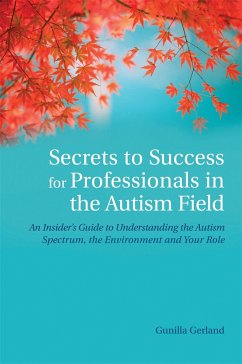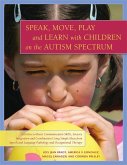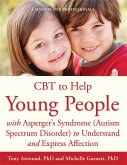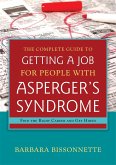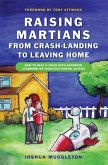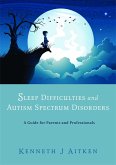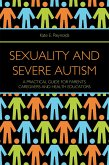Gunilla Gerland
Secrets to Success for Professionals in the Autism Field
An Insider's Guide to Understanding the Autism Spectrum, the Environment and Your Role
Gunilla Gerland
Secrets to Success for Professionals in the Autism Field
An Insider's Guide to Understanding the Autism Spectrum, the Environment and Your Role
- Broschiertes Buch
- Merkliste
- Auf die Merkliste
- Bewerten Bewerten
- Teilen
- Produkt teilen
- Produkterinnerung
- Produkterinnerung
Writing from an insider's perspective and an autism professional, Gerland offers original explanations of the characteristics of autism, showing how to discover the root cause of behaviours that are challenging, not just how to manage them superficially. She explains how to overcome common pitfalls to build more effective working relationships.
Andere Kunden interessierten sich auch für
![Speak, Move, Play and Learn with Children on the Autism Spectrum Speak, Move, Play and Learn with Children on the Autism Spectrum]() Corinda PresleySpeak, Move, Play and Learn with Children on the Autism Spectrum50,99 €
Corinda PresleySpeak, Move, Play and Learn with Children on the Autism Spectrum50,99 €![CBT to Help Young People with Asperger's Syndrome (Autism Spectrum Disorder) to Understand and Express Affection CBT to Help Young People with Asperger's Syndrome (Autism Spectrum Disorder) to Understand and Express Affection]() Michelle GarnettCBT to Help Young People with Asperger's Syndrome (Autism Spectrum Disorder) to Understand and Express Affection39,99 €
Michelle GarnettCBT to Help Young People with Asperger's Syndrome (Autism Spectrum Disorder) to Understand and Express Affection39,99 €![The Complete Guide to Getting a Job for People with Asperger's Syndrome The Complete Guide to Getting a Job for People with Asperger's Syndrome]() Barbara BissonnetteThe Complete Guide to Getting a Job for People with Asperger's Syndrome25,99 €
Barbara BissonnetteThe Complete Guide to Getting a Job for People with Asperger's Syndrome25,99 €![Raising Martians - From Crash-Landing to Leaving Home Raising Martians - From Crash-Landing to Leaving Home]() Joshua MuggletonRaising Martians - From Crash-Landing to Leaving Home22,99 €
Joshua MuggletonRaising Martians - From Crash-Landing to Leaving Home22,99 €![Sleep Difficulties and Autism Spectrum Disorders Sleep Difficulties and Autism Spectrum Disorders]() Kenneth AitkenSleep Difficulties and Autism Spectrum Disorders48,99 €
Kenneth AitkenSleep Difficulties and Autism Spectrum Disorders48,99 €![Sexuality and Severe Autism Sexuality and Severe Autism]() Kate E. ReynoldsSexuality and Severe Autism35,99 €
Kate E. ReynoldsSexuality and Severe Autism35,99 €![Teaching Theory of Mind Teaching Theory of Mind]() Kirstina OrdetxTeaching Theory of Mind51,99 €
Kirstina OrdetxTeaching Theory of Mind51,99 €-
-
-
Writing from an insider's perspective and an autism professional, Gerland offers original explanations of the characteristics of autism, showing how to discover the root cause of behaviours that are challenging, not just how to manage them superficially. She explains how to overcome common pitfalls to build more effective working relationships.
Hinweis: Dieser Artikel kann nur an eine deutsche Lieferadresse ausgeliefert werden.
Hinweis: Dieser Artikel kann nur an eine deutsche Lieferadresse ausgeliefert werden.
Produktdetails
- Produktdetails
- Verlag: Jessica Kingsley Publishers
- Seitenzahl: 384
- Erscheinungstermin: 15. Dezember 2012
- Englisch
- Abmessung: 228mm x 151mm x 22mm
- Gewicht: 556g
- ISBN-13: 9781849053709
- ISBN-10: 1849053707
- Artikelnr.: 36283539
- Herstellerkennzeichnung
- Libri GmbH
- Europaallee 1
- 36244 Bad Hersfeld
- gpsr@libri.de
- Verlag: Jessica Kingsley Publishers
- Seitenzahl: 384
- Erscheinungstermin: 15. Dezember 2012
- Englisch
- Abmessung: 228mm x 151mm x 22mm
- Gewicht: 556g
- ISBN-13: 9781849053709
- ISBN-10: 1849053707
- Artikelnr.: 36283539
- Herstellerkennzeichnung
- Libri GmbH
- Europaallee 1
- 36244 Bad Hersfeld
- gpsr@libri.de
Gunilla Gerland was diagnosed with Asperger syndrome several years ago. She has more than 15 years' experience in the autism field, working as a counsellor, supervisor and educator. She is well-known internationally for her autobiography A Real Person: Life on the Outside, and is very active in informing people about autism, through writing and lecturing all over Europe. She lives in Stockholm, where she also works closely with the Swedish National Autism Society. She is the author of Finding Out About Asperger Syndrome, High-Functioning Autism and PDD, also published by JKP.
1. Helping the Helper Help. A preface of sorts: about me, why and for whom.
Section I: The Professional Role...which deals with interactions and
reflects on professionalism. 2. The Framework and Ideologies - a chapter on
how it can be a constructive action to smash a window. 3. Same Same but
Different - a chapter for everyone but especially for those who have
previously worked in psychosocial treatment settings. 4. Just doing your
job or being a true professional? A chapter with some thoughts about what
professionalism could mean. 4.1. Awareness, Development and Change. 4.2.
Making right and doing wrong. 4.3 Empathy, ethics and moral competence.
4.4. Some ideas. 5. Remove the cake even if you don't think it's ready:
Common pitfalls for staff - A chapter on things you would rather avoid.
5.1. Pitfall 1 and 2: Falling into another role (than the professional) -
"Parent" or "Buddy". 5.2. Pitfall 3: That's the way he wants it! 5.3.
Pitfall 4: Prohibit or allow - this is not the question! 5.4. Pitfall 5:
Steering the will of others. 5.5. Pitfall 6: Excessive empathy. 5.6.
Pitfall 7: Lack of empathy. 5.7. Pitfall 8: Universal truths. 5.8. Pitfall
9: "We know this". 5.9. Pitfall 10: More normal than normal. 5.10. Pitfall
11: The gender trap? 5.11. Pitfall 12: Good aids that no one uses. 5.12.
Pitfall 13: "What if everybody...?" 5.13. Pitfall 14: Other children will
never accept... 5.14. Pitfall 15: Normality produces quality of life.
Section II: Understanding the Impairments...which deals with the symptoms
we often see and what may cause them. 6. "You never know if orange juice
will taste like orange juice." A chapter on sensory processing issues. 6.1.
The visual perception. 6.2. The tactile perception. 6.3. The auditory
perception. 6.4. The olfactory sense. 6.5. The sense of taste. 6.6.
Balance. 6.7. Proprioception - "Muscle and joint sense". 6.8. Interoceptive
senses. 6.9. Synaesthesia. 6.10. Sensory integration problems. 6.11.
Desensitization (Habituation). 6.12. Different is not always a problem.
6.13. How do we know, what do we do? 7. The man with two left feet - a
chapter on motor skills. 7.1. Motor automization. 7.2 Other motor
difficulties. 7.3. Practical implications. 8. One person may be of many
ages. - a chapter on the development perspective. 8.1. Mentalization in
practice. 9. Say what you mean and mean what you say - a chapter on
communication. 9.1. Language comprehension poorer than verbal expression.
9.2. Echolalia. 9.3. Truths, lies and subtext. 9.4. To announce your
actions. 9.5. Literal language comprehension. 9.6. Lack of "auto
correction". 9.7 "Attitude". 9.8. Restorative Communication. 9.9.
Repetitive communication. 10. Living without a spare gas can - a chapter on
energy and stress. 10.1. The drop excavates the stone (and the straw that
broke the camel's back). 10.2. Stress and stress management. 10.3. Sleep.
10.4. Time Perception. 11. I don't give a damn about the chores! A chapter
on cognition. 11.1. Executive functions. 11.2. Working memory. 11.3.
Categorization. 12. The short and boring chapter - a chapter on
definitions, incidence and other things you may want to know, but which are
of little help little in practice. 12.1. Definition. 12.2. Incidence. 12.3.
Causes. 12.4. Criteria. 12.5. Work-up. Section III: The Change
Process...which is an important element of the craftsmanship. 13. Can we
make a deaf person hear better by setting limits? A chapter on punishment
of "violations", and consequences of action. 13.1. Ch-ch-ch-ch-changes.
13.2. Truth and Consequence. 13.3. Making the professional "environmental
friendly". 13.4. Avoid a financial crisis on the trust account. 13.5. The
development of mature strategies - how does it come about? 14. CRAP - a
chapter with thoughts on the use of Confirmations or Rewards, the idea of
being Affirmative, and why Punishments do not work. 14.1. Attribution.
14.2. Penalty marking is banned! 14.3. A/C - Affirm and Confirm. 15. Diving
lessons in the ocean - a chapter on how to make assessments and analyses.
15.1. Assessment. 15.2. Analysis and hypothesis. 15.3. Intervention plan.
15.4. Evaluation. 15.5. Documentation. 15.6. Troubleshooting or "HELP - it
does not work!" 15.7. Finally, about assessments. 16. An underwater guide -
a chapter on common contributing factors in challenging behaviours. 16.1.
Self-esteem. 16.2. Ability to envision/imagine. 16.3. Developmental
perspective and Theory of Mind (mentalization). 16.4. Communication. 16.5.
There and then, here and now: When someone fights or injures himself. 17.
The danger of focusing on the behaviour itself - a chapter about what could
happen if you do not learn to dive. Section IV: Practical Intervention. 18.
The toolbox - an introduction to the tools. 19. Not having to learn to be
"as others" - a chapter on adjustments. 20. Inform more - and well! A
chapter on how we can work with information as a tool. 20.1. The individual
- "I do not have any bloody autism!" 21. Written, drawn and other visual
aids - an important chapter on matters that too many get too little of!
21.1. Choices and ability to envision. 21.2. Informed choices. 21.3.
Stress, overview and time. 21.4. TEACCH. 21.5. Social stories and comic
strip conversations. 21.6. Nag-free information. 21.7. The time model.
21.8. Five point scale. 21.9. The
Clothes-according-to-temperature-thermometer. 22. Talk, gab and babble, and
a little about how to play - a chapter on how to use conversation as a
tool. 22.1. Conversations for "landing". 22.2. Solution-focused
conversations. 22.3. Furnishing. 22.4. Conversations in group. 22.5.
Younger children: play skills. 22.6. Rule play. 23. Can you be yourself
when you do not know who you are? A chapter on working with self-knowledge
and self-esteem. 23.1. Thought - Feeling - Action. 23.2. Getting your
reality confirmed. 23.3. Positive feedback. 23.4. Balance of power. 23.5.
Better communication skills break powerlessness. 24. Methods and approaches
- a short chapter about some specific techniques that may be useful. 24.1.
Social stories and drawn conversations. 24.2. Solution-focused methods.
24.3. Cat-kit. 24.4. CBT. 24.5 Motivational interviewing. 25. Tips, tricks
and gadgets - a final chapter for filling your toolbox. 25.1. Learning to
shop. 25.2. Structure in the fridge. 25.3. Belt bag. 25.4. Smart phones and
apps. 25.5. Brushing teeth and hygiene. 25.6. Other stuff. 26.
Finally...the last chapter. 27. But wait a minute, was not the previous
chapter the last chapter? References. Index.
Section I: The Professional Role...which deals with interactions and
reflects on professionalism. 2. The Framework and Ideologies - a chapter on
how it can be a constructive action to smash a window. 3. Same Same but
Different - a chapter for everyone but especially for those who have
previously worked in psychosocial treatment settings. 4. Just doing your
job or being a true professional? A chapter with some thoughts about what
professionalism could mean. 4.1. Awareness, Development and Change. 4.2.
Making right and doing wrong. 4.3 Empathy, ethics and moral competence.
4.4. Some ideas. 5. Remove the cake even if you don't think it's ready:
Common pitfalls for staff - A chapter on things you would rather avoid.
5.1. Pitfall 1 and 2: Falling into another role (than the professional) -
"Parent" or "Buddy". 5.2. Pitfall 3: That's the way he wants it! 5.3.
Pitfall 4: Prohibit or allow - this is not the question! 5.4. Pitfall 5:
Steering the will of others. 5.5. Pitfall 6: Excessive empathy. 5.6.
Pitfall 7: Lack of empathy. 5.7. Pitfall 8: Universal truths. 5.8. Pitfall
9: "We know this". 5.9. Pitfall 10: More normal than normal. 5.10. Pitfall
11: The gender trap? 5.11. Pitfall 12: Good aids that no one uses. 5.12.
Pitfall 13: "What if everybody...?" 5.13. Pitfall 14: Other children will
never accept... 5.14. Pitfall 15: Normality produces quality of life.
Section II: Understanding the Impairments...which deals with the symptoms
we often see and what may cause them. 6. "You never know if orange juice
will taste like orange juice." A chapter on sensory processing issues. 6.1.
The visual perception. 6.2. The tactile perception. 6.3. The auditory
perception. 6.4. The olfactory sense. 6.5. The sense of taste. 6.6.
Balance. 6.7. Proprioception - "Muscle and joint sense". 6.8. Interoceptive
senses. 6.9. Synaesthesia. 6.10. Sensory integration problems. 6.11.
Desensitization (Habituation). 6.12. Different is not always a problem.
6.13. How do we know, what do we do? 7. The man with two left feet - a
chapter on motor skills. 7.1. Motor automization. 7.2 Other motor
difficulties. 7.3. Practical implications. 8. One person may be of many
ages. - a chapter on the development perspective. 8.1. Mentalization in
practice. 9. Say what you mean and mean what you say - a chapter on
communication. 9.1. Language comprehension poorer than verbal expression.
9.2. Echolalia. 9.3. Truths, lies and subtext. 9.4. To announce your
actions. 9.5. Literal language comprehension. 9.6. Lack of "auto
correction". 9.7 "Attitude". 9.8. Restorative Communication. 9.9.
Repetitive communication. 10. Living without a spare gas can - a chapter on
energy and stress. 10.1. The drop excavates the stone (and the straw that
broke the camel's back). 10.2. Stress and stress management. 10.3. Sleep.
10.4. Time Perception. 11. I don't give a damn about the chores! A chapter
on cognition. 11.1. Executive functions. 11.2. Working memory. 11.3.
Categorization. 12. The short and boring chapter - a chapter on
definitions, incidence and other things you may want to know, but which are
of little help little in practice. 12.1. Definition. 12.2. Incidence. 12.3.
Causes. 12.4. Criteria. 12.5. Work-up. Section III: The Change
Process...which is an important element of the craftsmanship. 13. Can we
make a deaf person hear better by setting limits? A chapter on punishment
of "violations", and consequences of action. 13.1. Ch-ch-ch-ch-changes.
13.2. Truth and Consequence. 13.3. Making the professional "environmental
friendly". 13.4. Avoid a financial crisis on the trust account. 13.5. The
development of mature strategies - how does it come about? 14. CRAP - a
chapter with thoughts on the use of Confirmations or Rewards, the idea of
being Affirmative, and why Punishments do not work. 14.1. Attribution.
14.2. Penalty marking is banned! 14.3. A/C - Affirm and Confirm. 15. Diving
lessons in the ocean - a chapter on how to make assessments and analyses.
15.1. Assessment. 15.2. Analysis and hypothesis. 15.3. Intervention plan.
15.4. Evaluation. 15.5. Documentation. 15.6. Troubleshooting or "HELP - it
does not work!" 15.7. Finally, about assessments. 16. An underwater guide -
a chapter on common contributing factors in challenging behaviours. 16.1.
Self-esteem. 16.2. Ability to envision/imagine. 16.3. Developmental
perspective and Theory of Mind (mentalization). 16.4. Communication. 16.5.
There and then, here and now: When someone fights or injures himself. 17.
The danger of focusing on the behaviour itself - a chapter about what could
happen if you do not learn to dive. Section IV: Practical Intervention. 18.
The toolbox - an introduction to the tools. 19. Not having to learn to be
"as others" - a chapter on adjustments. 20. Inform more - and well! A
chapter on how we can work with information as a tool. 20.1. The individual
- "I do not have any bloody autism!" 21. Written, drawn and other visual
aids - an important chapter on matters that too many get too little of!
21.1. Choices and ability to envision. 21.2. Informed choices. 21.3.
Stress, overview and time. 21.4. TEACCH. 21.5. Social stories and comic
strip conversations. 21.6. Nag-free information. 21.7. The time model.
21.8. Five point scale. 21.9. The
Clothes-according-to-temperature-thermometer. 22. Talk, gab and babble, and
a little about how to play - a chapter on how to use conversation as a
tool. 22.1. Conversations for "landing". 22.2. Solution-focused
conversations. 22.3. Furnishing. 22.4. Conversations in group. 22.5.
Younger children: play skills. 22.6. Rule play. 23. Can you be yourself
when you do not know who you are? A chapter on working with self-knowledge
and self-esteem. 23.1. Thought - Feeling - Action. 23.2. Getting your
reality confirmed. 23.3. Positive feedback. 23.4. Balance of power. 23.5.
Better communication skills break powerlessness. 24. Methods and approaches
- a short chapter about some specific techniques that may be useful. 24.1.
Social stories and drawn conversations. 24.2. Solution-focused methods.
24.3. Cat-kit. 24.4. CBT. 24.5 Motivational interviewing. 25. Tips, tricks
and gadgets - a final chapter for filling your toolbox. 25.1. Learning to
shop. 25.2. Structure in the fridge. 25.3. Belt bag. 25.4. Smart phones and
apps. 25.5. Brushing teeth and hygiene. 25.6. Other stuff. 26.
Finally...the last chapter. 27. But wait a minute, was not the previous
chapter the last chapter? References. Index.
1. Helping the Helper Help. A preface of sorts: about me, why and for whom.
Section I: The Professional Role...which deals with interactions and
reflects on professionalism. 2. The Framework and Ideologies - a chapter on
how it can be a constructive action to smash a window. 3. Same Same but
Different - a chapter for everyone but especially for those who have
previously worked in psychosocial treatment settings. 4. Just doing your
job or being a true professional? A chapter with some thoughts about what
professionalism could mean. 4.1. Awareness, Development and Change. 4.2.
Making right and doing wrong. 4.3 Empathy, ethics and moral competence.
4.4. Some ideas. 5. Remove the cake even if you don't think it's ready:
Common pitfalls for staff - A chapter on things you would rather avoid.
5.1. Pitfall 1 and 2: Falling into another role (than the professional) -
"Parent" or "Buddy". 5.2. Pitfall 3: That's the way he wants it! 5.3.
Pitfall 4: Prohibit or allow - this is not the question! 5.4. Pitfall 5:
Steering the will of others. 5.5. Pitfall 6: Excessive empathy. 5.6.
Pitfall 7: Lack of empathy. 5.7. Pitfall 8: Universal truths. 5.8. Pitfall
9: "We know this". 5.9. Pitfall 10: More normal than normal. 5.10. Pitfall
11: The gender trap? 5.11. Pitfall 12: Good aids that no one uses. 5.12.
Pitfall 13: "What if everybody...?" 5.13. Pitfall 14: Other children will
never accept... 5.14. Pitfall 15: Normality produces quality of life.
Section II: Understanding the Impairments...which deals with the symptoms
we often see and what may cause them. 6. "You never know if orange juice
will taste like orange juice." A chapter on sensory processing issues. 6.1.
The visual perception. 6.2. The tactile perception. 6.3. The auditory
perception. 6.4. The olfactory sense. 6.5. The sense of taste. 6.6.
Balance. 6.7. Proprioception - "Muscle and joint sense". 6.8. Interoceptive
senses. 6.9. Synaesthesia. 6.10. Sensory integration problems. 6.11.
Desensitization (Habituation). 6.12. Different is not always a problem.
6.13. How do we know, what do we do? 7. The man with two left feet - a
chapter on motor skills. 7.1. Motor automization. 7.2 Other motor
difficulties. 7.3. Practical implications. 8. One person may be of many
ages. - a chapter on the development perspective. 8.1. Mentalization in
practice. 9. Say what you mean and mean what you say - a chapter on
communication. 9.1. Language comprehension poorer than verbal expression.
9.2. Echolalia. 9.3. Truths, lies and subtext. 9.4. To announce your
actions. 9.5. Literal language comprehension. 9.6. Lack of "auto
correction". 9.7 "Attitude". 9.8. Restorative Communication. 9.9.
Repetitive communication. 10. Living without a spare gas can - a chapter on
energy and stress. 10.1. The drop excavates the stone (and the straw that
broke the camel's back). 10.2. Stress and stress management. 10.3. Sleep.
10.4. Time Perception. 11. I don't give a damn about the chores! A chapter
on cognition. 11.1. Executive functions. 11.2. Working memory. 11.3.
Categorization. 12. The short and boring chapter - a chapter on
definitions, incidence and other things you may want to know, but which are
of little help little in practice. 12.1. Definition. 12.2. Incidence. 12.3.
Causes. 12.4. Criteria. 12.5. Work-up. Section III: The Change
Process...which is an important element of the craftsmanship. 13. Can we
make a deaf person hear better by setting limits? A chapter on punishment
of "violations", and consequences of action. 13.1. Ch-ch-ch-ch-changes.
13.2. Truth and Consequence. 13.3. Making the professional "environmental
friendly". 13.4. Avoid a financial crisis on the trust account. 13.5. The
development of mature strategies - how does it come about? 14. CRAP - a
chapter with thoughts on the use of Confirmations or Rewards, the idea of
being Affirmative, and why Punishments do not work. 14.1. Attribution.
14.2. Penalty marking is banned! 14.3. A/C - Affirm and Confirm. 15. Diving
lessons in the ocean - a chapter on how to make assessments and analyses.
15.1. Assessment. 15.2. Analysis and hypothesis. 15.3. Intervention plan.
15.4. Evaluation. 15.5. Documentation. 15.6. Troubleshooting or "HELP - it
does not work!" 15.7. Finally, about assessments. 16. An underwater guide -
a chapter on common contributing factors in challenging behaviours. 16.1.
Self-esteem. 16.2. Ability to envision/imagine. 16.3. Developmental
perspective and Theory of Mind (mentalization). 16.4. Communication. 16.5.
There and then, here and now: When someone fights or injures himself. 17.
The danger of focusing on the behaviour itself - a chapter about what could
happen if you do not learn to dive. Section IV: Practical Intervention. 18.
The toolbox - an introduction to the tools. 19. Not having to learn to be
"as others" - a chapter on adjustments. 20. Inform more - and well! A
chapter on how we can work with information as a tool. 20.1. The individual
- "I do not have any bloody autism!" 21. Written, drawn and other visual
aids - an important chapter on matters that too many get too little of!
21.1. Choices and ability to envision. 21.2. Informed choices. 21.3.
Stress, overview and time. 21.4. TEACCH. 21.5. Social stories and comic
strip conversations. 21.6. Nag-free information. 21.7. The time model.
21.8. Five point scale. 21.9. The
Clothes-according-to-temperature-thermometer. 22. Talk, gab and babble, and
a little about how to play - a chapter on how to use conversation as a
tool. 22.1. Conversations for "landing". 22.2. Solution-focused
conversations. 22.3. Furnishing. 22.4. Conversations in group. 22.5.
Younger children: play skills. 22.6. Rule play. 23. Can you be yourself
when you do not know who you are? A chapter on working with self-knowledge
and self-esteem. 23.1. Thought - Feeling - Action. 23.2. Getting your
reality confirmed. 23.3. Positive feedback. 23.4. Balance of power. 23.5.
Better communication skills break powerlessness. 24. Methods and approaches
- a short chapter about some specific techniques that may be useful. 24.1.
Social stories and drawn conversations. 24.2. Solution-focused methods.
24.3. Cat-kit. 24.4. CBT. 24.5 Motivational interviewing. 25. Tips, tricks
and gadgets - a final chapter for filling your toolbox. 25.1. Learning to
shop. 25.2. Structure in the fridge. 25.3. Belt bag. 25.4. Smart phones and
apps. 25.5. Brushing teeth and hygiene. 25.6. Other stuff. 26.
Finally...the last chapter. 27. But wait a minute, was not the previous
chapter the last chapter? References. Index.
Section I: The Professional Role...which deals with interactions and
reflects on professionalism. 2. The Framework and Ideologies - a chapter on
how it can be a constructive action to smash a window. 3. Same Same but
Different - a chapter for everyone but especially for those who have
previously worked in psychosocial treatment settings. 4. Just doing your
job or being a true professional? A chapter with some thoughts about what
professionalism could mean. 4.1. Awareness, Development and Change. 4.2.
Making right and doing wrong. 4.3 Empathy, ethics and moral competence.
4.4. Some ideas. 5. Remove the cake even if you don't think it's ready:
Common pitfalls for staff - A chapter on things you would rather avoid.
5.1. Pitfall 1 and 2: Falling into another role (than the professional) -
"Parent" or "Buddy". 5.2. Pitfall 3: That's the way he wants it! 5.3.
Pitfall 4: Prohibit or allow - this is not the question! 5.4. Pitfall 5:
Steering the will of others. 5.5. Pitfall 6: Excessive empathy. 5.6.
Pitfall 7: Lack of empathy. 5.7. Pitfall 8: Universal truths. 5.8. Pitfall
9: "We know this". 5.9. Pitfall 10: More normal than normal. 5.10. Pitfall
11: The gender trap? 5.11. Pitfall 12: Good aids that no one uses. 5.12.
Pitfall 13: "What if everybody...?" 5.13. Pitfall 14: Other children will
never accept... 5.14. Pitfall 15: Normality produces quality of life.
Section II: Understanding the Impairments...which deals with the symptoms
we often see and what may cause them. 6. "You never know if orange juice
will taste like orange juice." A chapter on sensory processing issues. 6.1.
The visual perception. 6.2. The tactile perception. 6.3. The auditory
perception. 6.4. The olfactory sense. 6.5. The sense of taste. 6.6.
Balance. 6.7. Proprioception - "Muscle and joint sense". 6.8. Interoceptive
senses. 6.9. Synaesthesia. 6.10. Sensory integration problems. 6.11.
Desensitization (Habituation). 6.12. Different is not always a problem.
6.13. How do we know, what do we do? 7. The man with two left feet - a
chapter on motor skills. 7.1. Motor automization. 7.2 Other motor
difficulties. 7.3. Practical implications. 8. One person may be of many
ages. - a chapter on the development perspective. 8.1. Mentalization in
practice. 9. Say what you mean and mean what you say - a chapter on
communication. 9.1. Language comprehension poorer than verbal expression.
9.2. Echolalia. 9.3. Truths, lies and subtext. 9.4. To announce your
actions. 9.5. Literal language comprehension. 9.6. Lack of "auto
correction". 9.7 "Attitude". 9.8. Restorative Communication. 9.9.
Repetitive communication. 10. Living without a spare gas can - a chapter on
energy and stress. 10.1. The drop excavates the stone (and the straw that
broke the camel's back). 10.2. Stress and stress management. 10.3. Sleep.
10.4. Time Perception. 11. I don't give a damn about the chores! A chapter
on cognition. 11.1. Executive functions. 11.2. Working memory. 11.3.
Categorization. 12. The short and boring chapter - a chapter on
definitions, incidence and other things you may want to know, but which are
of little help little in practice. 12.1. Definition. 12.2. Incidence. 12.3.
Causes. 12.4. Criteria. 12.5. Work-up. Section III: The Change
Process...which is an important element of the craftsmanship. 13. Can we
make a deaf person hear better by setting limits? A chapter on punishment
of "violations", and consequences of action. 13.1. Ch-ch-ch-ch-changes.
13.2. Truth and Consequence. 13.3. Making the professional "environmental
friendly". 13.4. Avoid a financial crisis on the trust account. 13.5. The
development of mature strategies - how does it come about? 14. CRAP - a
chapter with thoughts on the use of Confirmations or Rewards, the idea of
being Affirmative, and why Punishments do not work. 14.1. Attribution.
14.2. Penalty marking is banned! 14.3. A/C - Affirm and Confirm. 15. Diving
lessons in the ocean - a chapter on how to make assessments and analyses.
15.1. Assessment. 15.2. Analysis and hypothesis. 15.3. Intervention plan.
15.4. Evaluation. 15.5. Documentation. 15.6. Troubleshooting or "HELP - it
does not work!" 15.7. Finally, about assessments. 16. An underwater guide -
a chapter on common contributing factors in challenging behaviours. 16.1.
Self-esteem. 16.2. Ability to envision/imagine. 16.3. Developmental
perspective and Theory of Mind (mentalization). 16.4. Communication. 16.5.
There and then, here and now: When someone fights or injures himself. 17.
The danger of focusing on the behaviour itself - a chapter about what could
happen if you do not learn to dive. Section IV: Practical Intervention. 18.
The toolbox - an introduction to the tools. 19. Not having to learn to be
"as others" - a chapter on adjustments. 20. Inform more - and well! A
chapter on how we can work with information as a tool. 20.1. The individual
- "I do not have any bloody autism!" 21. Written, drawn and other visual
aids - an important chapter on matters that too many get too little of!
21.1. Choices and ability to envision. 21.2. Informed choices. 21.3.
Stress, overview and time. 21.4. TEACCH. 21.5. Social stories and comic
strip conversations. 21.6. Nag-free information. 21.7. The time model.
21.8. Five point scale. 21.9. The
Clothes-according-to-temperature-thermometer. 22. Talk, gab and babble, and
a little about how to play - a chapter on how to use conversation as a
tool. 22.1. Conversations for "landing". 22.2. Solution-focused
conversations. 22.3. Furnishing. 22.4. Conversations in group. 22.5.
Younger children: play skills. 22.6. Rule play. 23. Can you be yourself
when you do not know who you are? A chapter on working with self-knowledge
and self-esteem. 23.1. Thought - Feeling - Action. 23.2. Getting your
reality confirmed. 23.3. Positive feedback. 23.4. Balance of power. 23.5.
Better communication skills break powerlessness. 24. Methods and approaches
- a short chapter about some specific techniques that may be useful. 24.1.
Social stories and drawn conversations. 24.2. Solution-focused methods.
24.3. Cat-kit. 24.4. CBT. 24.5 Motivational interviewing. 25. Tips, tricks
and gadgets - a final chapter for filling your toolbox. 25.1. Learning to
shop. 25.2. Structure in the fridge. 25.3. Belt bag. 25.4. Smart phones and
apps. 25.5. Brushing teeth and hygiene. 25.6. Other stuff. 26.
Finally...the last chapter. 27. But wait a minute, was not the previous
chapter the last chapter? References. Index.

